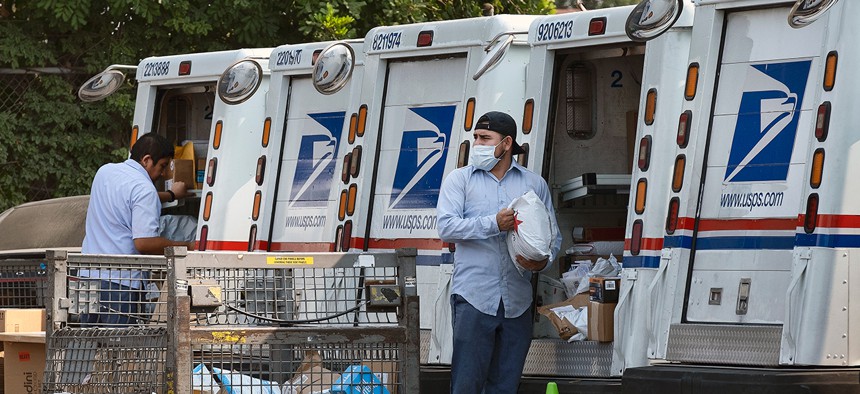
Postal workers load packages in their mail delivery vehicles in Los Angeles in August. Richard Vogel/AP
CDC Panel Designates USPS Workers as Next in Line for COVID-19 Vaccine
Postal employees are part of a group "critical to the functioning of society," per panel's recommendation.
Postal Service employees will be in the second group of Americans to receive the COVID-19 vaccine under a new distribution plan recommended by a federal advisory panel this week.
Postal Service employees are now slated to be in Phase 1b of vaccine distribution, as part of 49 million individuals older than 75 or part of the non-health care frontline essential workforce. The Center for Disease Control and Prevention’s Advisory Committee on Immunization Practices made its recommendation in a 13-1 vote, noting USPS workers were part of a group “critical to the functioning of society.”
USPS employees are part of the frontline workforce that has higher exposure rates to COVID-19 and are overrepresented by demographic groups that have been worst affected by the pandemic, ACIP said. Eighteen percent of postal employees are Black, 20% are Latino and at least 15% are more than 60 years old.
The exact timing of the distributions for postal workers and the logistics of delivering the shots remain in flux and will be subject to availability and state plans. States are still in their initial Phase 1a distribution to frontline health care workers and nursing home residents. Unlike several other federal agencies such as the Veterans Affairs Department and Indian Health Service, USPS was not slated to receive its own distribution of doses to vaccinate employees directly. CDC’s advisory group recommended bringing vaccination sites close to workers such as those at the Postal Service to ensure ease of access.
“Reaching workers in rural locations, shift workers, those with multiple jobs or working in small cohorts may be challenging,” ACIP said. “Personal investments in time and travel to obtain vaccine may be a barrier for some essential worker groups. Minimizing barriers to access vaccination for frontline essential workers, such as vaccine clinics at or close to the place of work, are optimal.”
Dave Partenheimer, a USPS spokesman, said the mailing agency is still working out the details of how its workforce will get inoculated.
“The Postal Service is working with federal, state, and local authorities to determine when Postal Service employees will be eligible to receive COVID-19 vaccinations as essential service workers, under state and local authority distribution plans,” Partenheimer said.
Like much of the country, USPS is in the midst of a major coronavirus outbreak. As of earlier this month, 14,000 postal workers were quarantining and 7,000 were positive for the virus. That amounted to more than one out of every 100 workers with active cases and two out of every 100 out of work. The uptick in cases—USPS has seen positive tests skyrocket by 43% in the last month—comes at a difficult time for the mailing agency, which always sees mail and package volume soar in December. The high rates of absenteeism have contributed to widespread delays during the holiday season. All told, more than 23,000 postal employees have tested positive for COVID-19 and more than 100 have died from related symptoms.
Postal management has engaged its unions in discussions on vaccine distribution, which it expects will take place around February. USPS is hopeful that it can set up vaccination sites at some of its larger facilities around the country, American Postal Workers Union President Mark Dimondstein said, but it will likely have to send staff at some locations that have only a few workers elsewhere to receive doses. Ideally different groups of workers would not be competing for the vaccine, Dimondstein added, though ultimately his group is pleased with the advisory panel’s recommendation.
“We support that essential workers will be next on the list and that will include postal workers,” he said.







